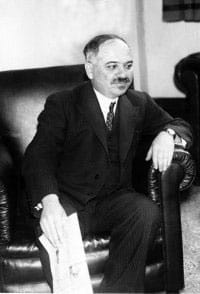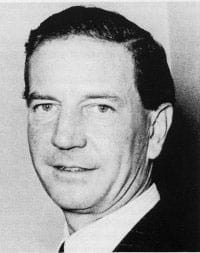

Philby was in charge of security for the Gibraltar area at that time. In Philby’s opinion, Stalin wanted General Sikorski’s death [3, p. 114]. As the chief of the British counterespionage for the Iberian Peninsula, Philby could easily find out the date of Sikorski’s visit to Gibraltar on his way from the Near East to London. In his version of events, the Soviets arranged for Maisky, their ambassador to London, to fly back via Gibraltar, and to be there at the same time as General Sikorski.

According to Philby, Churchill had been “tipped off” that this would happen, but “he was so frightened about the possible rupture with Stalin over the death [of] Polish officers that he said nothing by way of warning.” Therefore the occasion for ambassador Maisky’s prophecy to be fulfilled had come. On March 31, 1941, in a conversation with the Czechoslovakian legate to the Soviet Union, Zdenek Fierlinger, Maisky stated that he “can guarantee that General Sikorski will never enter Warsaw again” [1, p. 297].

On April 13, 1943, a Berlin radio station aired an announcement about the German army discovering near Smolensk mass graves of murdered Polish officers. Gen. Smorawinski was found among the corpses. As the official Russian radio announcement aired on April 15 confirms, Soviet Russia was dismayed. On the same day, at 11 AM, a cabinet meeting was held in Prime Minister Sikorski’s office. It was decided that the Ministry of Foreign Affairs would approach the Russian embassy to ask for an explanation, and the International Organization of the Red Cross would be asked by the Polish minister of defense to start an investigation of the matter. At noon the same day, Sikorski and minister Edward Raczynski met at 10 Downing Street with Churchill. Anxious that the news about the massacre might be true, Churchill noted that Bolsheviks could be cruel. He also warned: “There are things, although true, which should not be publicized without waiting for the right moment. It would be a mistake to reveal them all of a sudden” [2, p. 224]. Nonetheless, Gen. Sikorski warned that the Polish government would be forced to voice its opinion in the matter of the German revelations.

On May 1, 1943, William Averell Harriman spoke with Gen. Sikorski. Harriman, the U.S. ambassador to the Soviet Union at that time, was critical about the telegram addressed to the Red Cross referring to the Katyn massacre [6, p. 102]. He believed that sending the telegram, might have had a catastrophic impression in Moscow. Sikorski stated then that sending the telegram, when he was ill, was a mistake and he hoped to repair the situation. He also expressed his concerns about the Soviet expansion hurting the smaller nations of central Europe. Harriman shared his worries, but facing the upcoming election, he couldn’t support such ideas openly. In that time, before the Teheran conference, Harriman believed that when the Soviet Army took over Poland and her neighbors it would be too late for negotiations [6, p. 104]. William Averell Harriman considered Gen. Sikorski the only Polish statesman able to negotiate with Stalin [6, p. 102-103].
Any action against the Polish government-in-exile would be successful if the government had not dismissed German accusations right away. Soviet diplomacy skillfully played with the news of the massacre, trying to weaken Sikorski’s position in world politics. His physical removal was just a next step.
From 19 – 23 July 1943, a key conference regarding Poland’s eastern border was held in the Foreign Office. On July 23, Anthony Eden and other high officials decided to send to ambassadors of the United Kingdom in Moscow and Washington a set of documents regarding obligations of Great Britain to Poland in the matter of the Polish-Soviet border. The set contained documents presenting the Russian standpoint and explaining the position of the London officials in the conflict. The above-mentioned set of documents did not contain the secret protocol, which was added to the pact signed on August 25, 1939.
On July 26, 1943, Churchill met Polish president Wladyslaw Raczkiewicz. During the meeting, Churchill spoke about the need of rebuilding a strong and independent Poland. He believed that most probably the Red Army would liberate Poland. He also told the president he couldn’t guarantee anything regarding future Polish borders, stating: “I have never promised and I will never give my political support to any shape of the Polish eastern border” [5, p. 267]. The British ambassador to the Polish government, Owen O’Malley, who was also present during the conversation, noted the fact that Stalin’s expansion reached terrains ethnically not Russian. Two days later, on July 28, the Secretary of State of Great Britain in the Middle East, Richard Casey, in a conversation with the Soviet Admiral Charlamov, got to hear that: “Soviet Russia fights to regain the old borders of the Czar’s Empire” [5, p. 267]. Old Russian imperialism had many followers in Soviet Russia.
At that time, the Foreign Office believed that the root of evil of the conflict of Sikorski’s government with Russia was the problem of the Polish-Soviet border. On July 15, 1943, the ambassadors of the United Kingdom and the U.S.A. informed the Soviets about their need to meet Stalin. But Stalin avoided such a meeting for another month, finding excuses in being on the battlefield. Not earlier than August 11, the ambassadors of the U.K. and the U.S.A. in Moscow, Archibald Clark Kerr and Admiral William Standley, finally saw Stalin. Both ambassadors appealed to the Russian leader to agree to evacuate Polish citizens from Soviet Russia. The action was supposed to improve Polish-Russian relations. Standley declared then that the problem of European borders should be solved after the war in the form of a peace treaty. Stalin and Molotov listened to the ambassadors, but they did not give any commentaries.
To be continued…
Selected bibliography:
1. Kaminski Marek Kazimierz, Edvard Beneš kontra gen. Wladyslaw Sikorski, Wydawnictwo Neriton, Instytut Historii PAN, Warszawa 2005.
2. Kukiel Marian, General Sikorski, Zolnierz i Maz Stanu Polski Walczacej, Instytut Polski i Muzeum im. gen. Sikorskiego, Londyn 1970.
3. Heinrich Müller, Gregory Douglas, Müller Journals: 1948-1950 the Washington Years, Volume 1, Bender Publishing, San Jose, 1999.
4. Szafran Czeslaw, Kontrowersje wokol katastrofy gibraltarskiej, in: Moszumanski Zbigniew, Zuziak Janusz [Editors], General Wladyslaw Sikorski, Szkice historyczne w 60. rocznice smierci, Wyd. Adam Marszalek, Torun 2004.
5. Tebinka Jacek, Polityka brytyjska wobec problemu granicy polsko-radzieckiej 1939 – 1945, Wydawnictwo Neriton, Instytut Historii PAN, Warszawa 1998.
6. Wandycz Piotr, Harriman a Polska, „Zeszyty Historyczne” nr 79, s. 88-115, Paryz 1987.
By Józef Kazimierz Kubit
Translation: Kasia Miszta
Was General Sikorski a victim of the Katyn massacre? Part I
